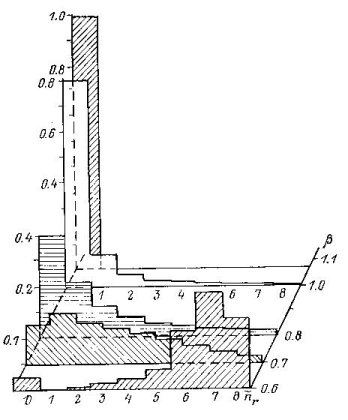When
a Rydberg p-state is situated exactly in the middle of two s-states,
important physical applications of Rydberg atoms in quantum logic
become possible due to realization of the "dipole blockade" [1].
Quantitatively, the double-photon resonance occurs when the
difference
 between quantum defects of the states involved in the coupling is
equal to ½. We show here that the blockade effect is
accomplished with the suppression of radiative spontaneous processes.
between quantum defects of the states involved in the coupling is
equal to ½. We show here that the blockade effect is
accomplished with the suppression of radiative spontaneous processes.
The
reasons for suppressed photoionization were discussed in details by
Seaton [2] (the Cooper minimum in atomic photoionization cross
sections). His arguments about small overlap of wave functions
associated with transitions
Fig. 1 Natural emission spectra in Sommerfeld atom. Blockade effect is
realized for β = 0.5 are well established: the difference
are well established: the difference
 must be close to a half-integer value for the optical transition to
be unefficient. The decrease in the efficiency of radiative processes
can be interpreted using classical orbits of Rydberg electrons (RE)
[2]. When a given l-state is very close to the continuum, the
semi-classical treatment yields that the value
must be close to a half-integer value for the optical transition to
be unefficient. The decrease in the efficiency of radiative processes
can be interpreted using classical orbits of Rydberg electrons (RE)
[2]. When a given l-state is very close to the continuum, the
semi-classical treatment yields that the value
 is equal to the scattering angle
is equal to the scattering angle
 of the slow RE by the ionic core. Hence, classical scattering does
not occur when μΔ = 0.5, and, consequently, the probability of
photon absorption is small, and there is no emission. The absence of
classically emitted radiation obviously results in anomalously small
natural linewidths.
of the slow RE by the ionic core. Hence, classical scattering does
not occur when μΔ = 0.5, and, consequently, the probability of
photon absorption is small, and there is no emission. The absence of
classically emitted radiation obviously results in anomalously small
natural linewidths.

 with the parameter
with the parameter
 ,
which is directly related to the RE scattering angle
,
which is directly related to the RE scattering angle
 ,
is shown in Fig. 1 for the case of a Sommerfeld type model potential
,
is shown in Fig. 1 for the case of a Sommerfeld type model potential
 [2]. Photons are emitted by the (nr = 8, l = 1) level to a range of
lower levels with radial quantum number
[2]. Photons are emitted by the (nr = 8, l = 1) level to a range of
lower levels with radial quantum number
 .
The area under curves is normalized to unity. In the vicinity of
.
The area under curves is normalized to unity. In the vicinity of
 ,
where p-states are expected to become metastable (
,
where p-states are expected to become metastable ( ),
the probability distribution of the emission acquires a form
characteristic for black-body radiation, which agrees with the
conceptions of de Broglie [3]
),
the probability distribution of the emission acquires a form
characteristic for black-body radiation, which agrees with the
conceptions of de Broglie [3]